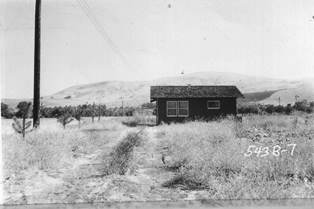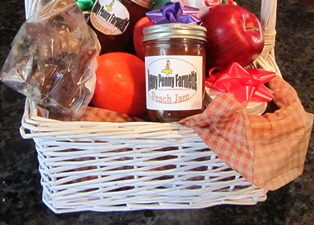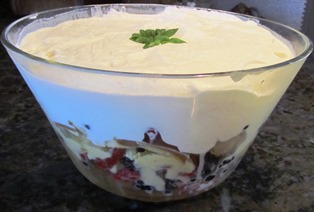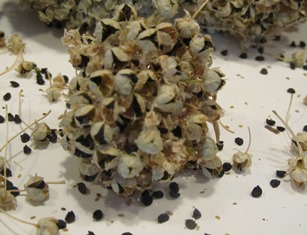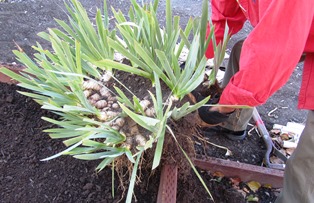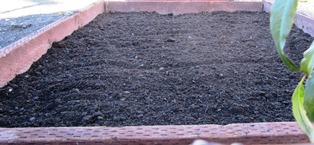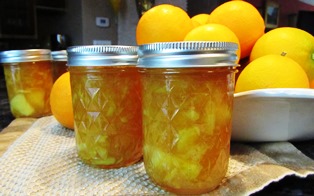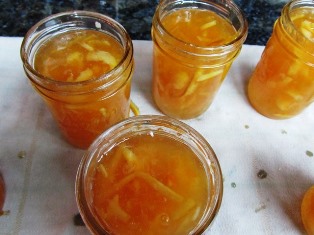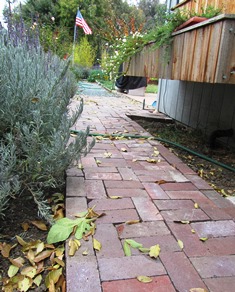Archive for December, 2013
The Farmette Renovation Work Continues through All Seasons
I met with the tax assessor last month and he gave me a picture of our small farmette house from 1953. At that time, the house was only six months old. Over the ensuing years, many changes were made, rendering the tiny miner’s shack or bunkhouse (that appears to have been a single room) into a 2-bedroom, 2 bath house of roughly 1,000 square feet. We continue to renovate but limited resources slows everything. Eventually, we’ll have a small finished house in a lovely environment.
When we found the property in 2009, it was in foreclosure and looked like a dump. That’s because it had been used as one. Broken pieces of granite and cabinetry wood had been piled along its aging, rotting fences, too weak and weary to remain upright. Inside, the hardwood floors had been ripped off and everything that could be “harvested” from the house by others had been taken. The only appliance was an old refrigerator sitting a weed-field that served as the back yard.
But we saw land all around. Rising up to the north in back of our farmette are hills (emerald green in the rainy season) that separate the inland valley where our farmette is located from the great Central Valley of California. Seeming as near as our front yard, the blue-green peaks of Mount Diablo tower over the landscape in the east and southeast (we now see these from our living room couch and front porch). From the northwest in summer, the breezes off the San Francisco Bay where it becomes the Straits of Carquinez blow toward Mount Diablo around 4:00 P.M. every day to cool the area.
After pulling out the weeds that at one point towered over our heads, we envisioned re-engineering everything. We constructed a new landscape that included fruit, citrus, and nut trees, beds for roses and other flowers, an heirloom herb and vegetable garden, and a designated area for bees and chickens.
Without a huge budget, we believed the renovation of the house would be ongoing (and it has been). This is our fourth winter. When we are not working outside, we are working on the renovation inside. For example, recently we installed window trim in the living room. Today, I’ll caulk, spackle, and sand in preparation for painting later this week.
Previously the entry into the house was through a side door and bathroom. The first impression wasn’t good. My husband created a welcoming entrance with exterior moldings around the windows and door. I talked him into a screen door and a porch (as yet unfinished) with a trellis to support purple wisteria.

A flagstone path lined with roses and citrus trees leads to the new front door but the porch is yet to be finished
Since unseasonably warm temperatures have been forecast for the week, we have begun work on a flagstone walkway leading to the porch. I love when Carlos gets out string, stakes, and the can of marking spray and begins putting down boundaries for fences, walkways, stone paths, and garden gates. The tax assessor didn’t ask about those markings. But we expect the property value to be listed higher next year because of the renovation we’ve already done.
Divine Desserts and Holiday Cheer
We decorated festive holiday baskets for family and friends this year, filling them with tangerines and oranges from our trees, juicy apples, jars of summer fruit jams, and honey. Of course, no holiday basket would be complete without a batch of homemade fudge, some sugar cookies, and bottle of apple cider or a favorite cordial.
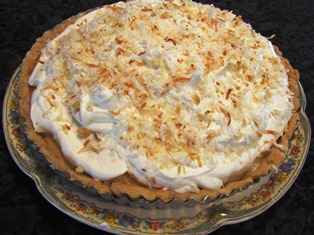
The coconut cream pie piled high with whipped cream and toasted coconut is always a hit for a Christmas dessert
Some of our baskets were delivered on Christmas Eve; others we took with us to a family gathering on Christmas day. I’ve been told that the baskets are much appreciated, more so, since they include homemade treats made with love.
Christmas Eve day my son and I spent most of the day in the kitchen, baking and decorating the cookies, toasting coconut for the pie, and assembling the trifle for our Christmas day dinner.
The trifle bowl went missing this year (we think it was mistakenly taken home by someone after our Thanksgiving feast). But it didn’t really matter since we could make the trifle and put it in any glass bowl that might be deep enough to hold the layers of pound cake and seven cups of various fruits and berries.
We didn’t cook the Christmas dinner this year–my daughter did. But we supplied some a few desserts and a lot of Christmas cheer. Some might say we were blessed with beautiful weather (hovering close to 70 degrees Fahrenheit), but I’d say it’s a mixed blessing–those high, firm peaks of whipped cream in on the trifle and pies will surely soften and sag during transport. But the desserts will still taste divine.
Salivating Over New Organics from Old and Rare Seed
What I love most about the onset of winter is the arrival of the seed catalogs. Armed with the newest one, I enjoy sitting on the porch, warming my bones under the pale winter sun, and reading about what I could be growing on the Henny Penny Farmette this spring–like the onions from rare, old seed that Bountiful Gardens offers in its 2014 catalog.
Bountiful Gardens is a nonprofit organization located in Willits, California (160 miles north of San Francisco). The organization has signed the Safe Seed Pledge and promises to never knowingly buy or sell seeds that are GMO (genetically modified).
The onion seed I’m eager to purchase is the Mill Creek Red Onion–a special heirloom I read about that is considered to be bolt-resistant and grows well in spring or fall. According to the catalog, the onion was bred by nursery owners Joe and Wanda Turi, who have since passed away. Thanks to the folks at Bountiful Gardens, a box of the Turi’s onions was acquired, ensuring the rare seed would be preserved and multiplied in gardens like mine and yours.
Another vegetable I want to try is the Early Purple Sprouting broccoli, a European heirloom that grows into a large plant with purple heads possessing excellent nutritional value and flavor. An August planting is recommended because the plant needs to survive through a winter to become productive.
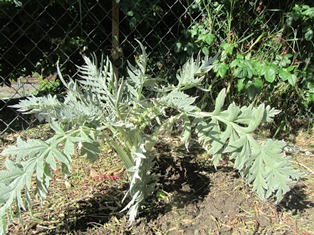
I managed not to kill the artichoke I planted last year and, thus encouraged, I would like to grow some other varieties
The artichoke (cynara cardynculus) listing in the catalog also intrigues me. The plant won’t produce chokes during its first year, but I don’t mind. Having an abundance of chokes for farmette meals makes me want to send for the seed right now. Don’t even get me started on all the herbs I want to order and plant! I might have to turn the farmette into a farm.
The Bountiful Gardens 2014 catalog is one of the best. Not only are the listings intriguing to read, the full-color pictures are nothing short of seductive for a gardener. Offerings include heirloom, open-pollinated, untreated seeds for sustainable growing of vegetables, grains, oil and forage crops, wild trees and shrubs, berries, herbs, and flower. The catalog even offers mushroom spawn. There are also books and media products available on gardening topics, composting, permaculture, self-sufficiency, garden pests, tools, seed saving, and much more.
If you are interested in getting your own copy of the 2014 catalog, write to Bountiful Gardens, 18001 Shafer Ranch Road, Willits, CA 95490; phone 707-459-6410. Or email: bountiful@sonic.net. See, http://www.bountifulgardens.org
Certain Plants And Chickens Don’t Go Together
Chickens are curious creatures. Spend a hour watching them scratch, poke, and peck and you’ll see what I mean.
I’ve never lost a free-range chicken because of something it ate; but it seems as though they’ll eat anything. It got me thinking that a variety of plants commonly grown in landscapes and backyard gardens could make chickens ill if they ate the berries, nuts, or leaves of those plants.
The following represents a small sampling of common plants that could make your feathered friends sick or even poison them.
- Acorn
- Alfalfa
- Azalea
- Daffodil
- Eggplant
- Foxglove
- Hemlock
- Jasmine
- Jimson Weed
- Lamb’s Quarters
- Lantana
- Milkweed
- Nicotiana (tobacco)
- Oleander
- Oxalis
- Poison Ivy
- Poison Oak
- Pokeweed
- Pyracantha
- Red Maple
- Rhubarb
- Sweet Pea
- Tulip
- Wild Onion
- Wisteria
Chickens are foraging birds and have good natural instincts. They will taste a plant and if something isn’t right, they’ll likely leave it. If you allow them to forage for themselves in pasture, more often than not, they’ll eschew the poisonous plants in your garden or landscape for the rich diversity of what they find in open pastureland.
Divide Irises to Regenerate the Plant and Get Spectacular Blooms
Dividing the rhizomes of bearded iris plants is an easy and necessary process as the plant ages. The division process is best done during late summer or early fall, but we are doing this job now on our farmette.
The rhizome is a thick tuberous type of structure that sends up stems and leaves and also produces roots. Many gardeners divide their iris clumps every three to four years. Our beds of iris have become overcrowded with many new baby plants. It’s time to divide.
Before we move our iris from the side garden to planter boxes made of pressure-treated redwood, we prepare the soil in those boxes. We amend it with low-nitrogen fertilizer and compost.
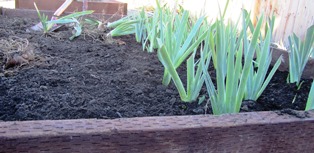
These iris are planted too close–they will be replanted to 16 inches apart for air to circulate and for growing room
We cut back the foliage and pull off any of the sword-shaped leaves that have dried. Then we gently pull apart the new growth from the old clump. Pruning and cutting back the leaves helps ensure that pests do not overwinter.
The rhizome produces more rhizomes over time. Eventually the original rhizome will wither and die. Regularly dividing the clumps ensures new baby plants and blooms for years to come.
Eggstra Confusing Egg Labels
Just because an egg is organic and from a cage-free chicken does not mean the eggs are free from Salmonella Enteritidis (the bacteria that causes the foodborne illness) or that the chickens producing the eggs live free of confinement.
Supermarkets carry dozens of eggs with labels like pasteurized or organic and also free-range, cage-free, or vegetarian. Consumers can find it confusing, so here’s the low-down on eggs and their labels.
CAGE FREE
This term relates to how the chicken is confined. The chickens are not raised in cages but may be confined in barns with floors. The floors may have pine shavings or other material and the chickens will likely have nesting boxes in which to lay eggs and roosts. But cage free does not necessarily mean they have lots of space; they could be living in close confinement with many other birds, depending on the farm.
ORGANIC
In order to get the USDA certification for organic on the eggs, the chickens must not be given hormones, antibiotics, and other drugs. The hens can be caged or otherwise confined, but usually they are cage free and eat an organic diet. The USDA stipulates that to qualify as organic eggs, the layers must be fed an organic diet of grains from land deemed free from toxic chemicals and pesticide for a minimum of three years and no grain from genetically-modified crops.
FREE RANGE
Chickens considered free range are able to leave their confinement and roam freely. Depending on the farm, the birds may be under a protective covering like a canopy. This keeps the flyers from escaping and the hawks from carrying away the birds. Free-range chickens might have a richer diet, again depending on the farm, because of greater access to freely foraging on grasses, grains, and seeds.
VEGETARIAN
How, you might wonder, can a chicken be deemed vegetarian when they naturally forage for grubs and worms? They are confined in cages and fed a vegetarian diet, free of animal and fish by-products.
PASTEURIZED
The eggs containing a pasteurized label have been put through a heating process while still in their shells. For three and one-half minutes, the eggs are heated to 140 degrees Fahrenheit, thereby killing the Salmonella bacteria. Pasteurized eggs are preferable for the diet of young children, elderly people, and those who have weakened immune systems and for whom a salmonella infection might have grave consequences. Even if you don’t buy pasteurized eggs, you can eliminate the risk of Salmonella infection if you cook the egg yolk and white until firm.
SAFETY TIPS
Eggs collected from your hen house should be washed within 36 hours of being collected and immediately refrigerated at 45 degrees Fahrenheit or below. These two steps can reduce the risk of Salmonella. Refrigeration prevents the bacteria (if present) from multiplying. Eggs purchased from the store should be immediately refrigerated. And if a recipe lists a raw egg as an ingredient (for example, mayonnaise or salad dressing or cake frosting), use pasteurized eggs or egg whites.
An egg from a pasture-raised hen is much more nutritious than an egg from a large commercial enterprise, according to Mother Earth News. The publication did a study in 2007 that measured how eggs from pastured hens stack up against the USDA’s nutrient data for commercial eggs. The results suggested that eggs from the pastured chickens were nutritionally superior. For the full story, see, http://www.motherearthnews.com/real-food/tests-reveal-healthier-eggs.aspx
• 1/3 less cholesterol
• 1/4 less saturated fat
• 2/3 more vitamin A
• 2 times more omega-3 fatty acids
• 3 times more vitamin E
• 7 times more beta caroten
It might be time to acquire a few more chickens if you love eggs as much as I do, especially in those big, mid-day farm table breakfast/lunches, with fresh veggies from the garden, and homemade bread and jam.
If Your Chickens Aren’t Cold Hardy, What Can You Do?
Chickens that can tolerate extreme cold are considered cold-hardy. The Dominique, Hamburg, Langshan, Sussex, and Wyandotte breeds are considered chill tolerant (even cold-hardy) but breeds such as Crevecoeur and Catalana are less tolerant of temperature extremes. So are Bantams and some breeds with large, single combs.
The chickens generate body heat that helps alleviate the cold temperature of a coop. They also wear feathered coats and will huddle together for warmth. A hen house that has insulation and perhaps a south-facing window that captures the warmth of a winter sun can also mitigate extreme cold.
Still, if you live in an area where the temps are below freezing, where it snows, and where the wind contributes to the chill, you might want to hang an ordinary light bulb (40-60 watts) or a 50-watt red bulb if you worry about frost-bitten chickens on those coldest nights.
Put that lamp on a timer. But beware of hanging any electric light that could get knocked down. It could set your coop on fire. And cold-tolerant breeds probably don’t need the extra heat anyway.
Perhaps equally, if not more, important are the chickens’ need for fresh water, ventilation, and a dry environment during winter. You don’t want the chickens roosting in a draft, but you do need ventilation in the coop, for example, via egg-access doors, windows, or ventilation holes with screens. They also need a dry environment.
If the coop isn’t insulated, you might stack bales of straw or hay along the walls and scatter pine shavings if your coop has an earthen floor that becomes cold or frozen.

This chicken house has egg access doors, a human door, a window, and is insulated; the art is optional.
Cold-hardy chickens probably will make it through most frosty nights with few to no problems. Your best tool is your ability to observe your chickens for problems. Oh, and you might want to place a thermometer inside the coop for an accurate measurement about how cold it really gets when the ladies (and rooster, too) are all inside.
Don’t judge your chickens’ endurance for cold by your own.
Easy Orange Marmalade
Who can resist the flavors of homemade jams? Whether it embellishes an appetizer of grilled fig and melted goat cheese or is spread upon a fat slice of fresh-baked bread, jam has power to elevate any meal to another level.
Using the seedless oranges growing on our farmette trees, I’m making marmalade. Marmalade made with the oranges ripening this time of year make great additions to holiday gift baskets. I like to add jars of honey, fresh tangerines, nuts, summer jams, and homemade treats.
RECIPE FOR ORANGE MARMALADE
Ingredients:
4 large oranges (preferably a seedless variety)
2 medium lemons
1/2 teaspoon butter (to reduce foaming)
1/8 teaspoon baking soda
6 Tablespoons dry classic pectin
5 1/2 cups sugar
Directions for Preparing the Jars and Canner:
Wash pint jars in the dishwasher or wash the jars and screw rings in hot soapy water, rinse, and drain upside down on paper towels.
Remove the wire rack from the canner and set aside; then, fill the canner half full of water and bring to a simmer.
Directions for Making the Fruit Mixture:
Wash the oranges and lemons.
Peel the fruit, using a vegetable peeler or a sharp paring knife. Discard any seeds and the pithiest parts of the inner peeling as the pith tastes bitter.
Cut the peeled skins into narrow strips.
Pour water into a saucepan.
Add baking soda and strips of peel.
Bring to boil and then reduce the heat, simmering for 20 minutes and stirring as needed.
Cut the fruit into thin quarters.
Add the fruit and juice to the saucepan of simmering peelings, cover, and allow everything to simmer for 10 minutes.
Remove 4 cups of the fruit/peeling/juice mixture and pour into a large saucepan (6 or 8 quart) or stock pot.
Stir in the pectin and add the butter and sugar, mixing well.
Bring to a roiling boil, stirring constantly, for a full minute and then remove from heat, skimming off any foam.
How to Can the Marmalade:
Ladle the fruit mixture into the warm, clean jars, leaving between 1/4 and 1/8 inch space from the top.
Wipe the jar rims before placing the jars on the wire rack of the canner.
Lower the wire rack of jars into the simmering water in the canner.
Make sure the jars are covered by 2 inches of water (add boiling water if necessary).
Cover with lid and boil for 15 to 20 minutes.
Turn off flame, remove the jars of marmalade, and set them onto a towel to cool.
Listen for the popping sound that signals the lids have sealed. Check lids for seal once the jars have cooled by pushing against the center of the lid. If it springs, the jar has not sealed and must be refrigerated. The marmalade will still be good to eat.
Plunging Temperatures–The Perfect Time to Bring Out the Honey
Cold and flu season is upon us. Here in Northern California, temps are plunging into the 20s and 30s and snow may be on its way. It is important to have a strong immune system to fight off these winter maladies.

A frozen sheet of ice blocks the cork (permitting honeybees to drink) from moving in our backyard fountain
I’m taking down another jar of honey from the shelf where I stacked the jars over the summer. One teaspoon of raw buckwheat honey taken daily has been recommended by doctors as a powerful booster for the immune system. See http://www.prweb.com/releases/honey/buckwheat-honey-raw/prweb10242276.htm.
With the weather change comes the cold and flu season, so I shouldn’t have been surprised that my husband came home from work yesterday feeling out of sorts. Our neighbors have all been sick with colds and he’s concerned that he might have caught the bug.
I made him a cup of hot ginger tea, sweetened with raw honey. Honey can be consumed directly from the spoon or in hot water or in a tea or infusion with lemon.
I became a believer in honey and ginger tea years ago while studying Tai Chi. My 84-year-old teacher swore by drinking hot tea made by steeping an inch or two of fresh, peeled ginger and adding lemon and honey. Her stamina was nothing short of remarkable–she not only did Tai Chi, but sang opera, painted Chinese brush paintings, and taught many classes on herbs, reflexology, and other aspects of health and fitness in California and Hawaii.
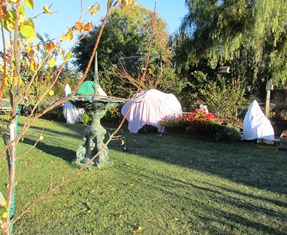
Using sheets and blankets, we’ve covered the citrus trees around our farmette as temps are expected to plunge into the 20s tonight
Holistic practitioners have long espoused belief in the healthful benefits of raw honey. Honey was used by the ancient Greeks and Romans for a variety of maladies. Modern medical doctors and researchers have extolled honey’s antiseptic, antibacterial, and anti-inflammatory properties, and many cold and flu preparations contain honey as an ingredient. It a cost-effective way to treat a cough. See http://www.mayoclinic.com/health/honey/AN01799
Honey is the only food on the planet that does not go bad. It may crystallize, but it never becomes sugar. Crystallized honey in a jar can be returned to liquid by removing the lid and setting the jar in warm water. Never heat honey in the microwave or boil it because it will destroy the natural enzymes. And never give honey to a child under the age of one year because of the risk of their developing botulism.
You don’t have to wait to start gaining the benefit of raw honey. You can strengthen your immune system now before the dreaded cold and flu sweeps through your neighborhood. Daily consumption of a teaspoon of raw honey (from flower-fed bees) that has been minimally filtered can be good for your health and, especially, your immune system.
Less Mopping, More Writing
It may not be immediately apparent what recycled bricks have to do with writing, but bear with me. A friend who does professional demolition of houses and properties brought us a truckload of bricks from an owner who was re-landscaping his upscale property in a nearby East Bay city. Otherwise, those bricks were destined to be discarded in a landfill.
Temperatures hovered near 70 degrees Fahrenheit this past weekend (Thanksgiving) and the weather was perfect for us to lay a brick walkway. My architect husband and I are passionate about recycling materials that still have life in them. It’s one of the reasons why two of our favorite places to visit are architectural salvage yards in Berkeley: Ohmega and Urban Ore. See http://www.ohmegasalvage.com/ and also see http://UrbanOre.com/
With the rainy season on its way, it seemed like a good idea to lay the brick in a pattern along the northwestern side of the house where we keep the recycle and garbage bins. During winter, we track a lot of mud into our small farmette home because we have only dirt and gravel paths through the garden and orchard areas.
This year, it will be different. The newly laid brick walkway runs from the front to the rear of the house, joining the front porch (that we are currently building) with a gravel path leading to the property line. We laid out the brick pattern and tapped them close together, using a rubber mallet (since hitting brick on brick can cause breakage).
We still need to pour sand on top and sweep it into the cracks. But this kind of path can last for years. The ancient Romans built similar paths that remain to this day. The rains will come, but less mud will be tracked in because of the paving stones. That means for me fewer hours this winter spent mopping the mud tracked in and more time writing on my cozy mystery series.
 Facebook
Facebook Goodreads
Goodreads LinkedIn
LinkedIn Meera Lester
Meera Lester Twitter
Twitter




